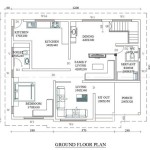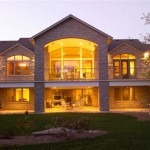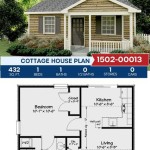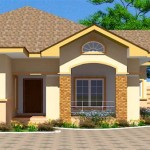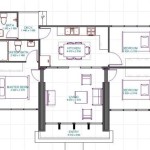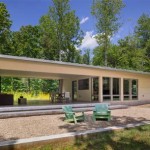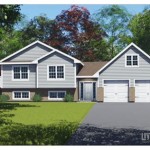3 Bed Duplex House Plans: Exploring Options and Considerations
A 3-bed duplex house plan offers a versatile housing solution, accommodating various lifestyles and needs. Whether intended for multi-generational families, rental income generation, or simply a desire for more space, understanding the different plan types and key considerations is crucial for making informed decisions.
Duplex homes are essentially two separate living units within a single building. They can be configured in various ways, affecting the layout, privacy, and overall functionality. Common configurations include side-by-side duplexes, where the units share a common wall, and stacked duplexes, where one unit is located above the other. Each configuration presents its own advantages and disadvantages in terms of space utilization, construction costs, and privacy.
Within the 3-bed duplex model, there's further variety in floor plans. Some plans prioritize open-plan living, creating spacious combined kitchen, dining, and living areas. Others maintain separate, more traditional room divisions. Bedrooms can be clustered together or distributed throughout the unit, influencing noise levels and privacy. The placement of bathrooms, laundry facilities, and storage spaces also significantly impacts daily living.
One of the primary advantages of a 3-bed duplex is its adaptability to different occupancy scenarios. It can comfortably house a larger family in one unit while generating rental income from the other. Alternatively, it can accommodate extended family members, providing independent living spaces while maintaining close proximity. This flexibility makes 3-bed duplexes a popular choice for investors and homeowners alike.
When considering a 3-bed duplex plan, careful attention should be paid to the overall square footage of each unit. This factor influences not only the living space but also the potential rental income. Larger units generally command higher rents, while smaller units may attract a wider range of tenants. Balancing size with functionality and affordability is key.
Outdoor space is another important element to consider. Whether it's a shared yard, separate patios, or balconies, outdoor areas enhance the living experience. Careful planning of these spaces can maximize privacy and optimize the use of available land. Incorporating landscaping and outdoor amenities can further enhance the appeal and value of the property.
Parking provisions are crucial, especially if the duplex is intended for multiple families or tenants. Adequate off-street parking, whether in the form of a driveway, carport, or garage, should be factored into the plan. The local zoning regulations regarding parking requirements should also be carefully reviewed.
Building codes and regulations play a significant role in duplex construction. These codes dictate various aspects of the building process, including structural integrity, fire safety, and accessibility. Compliance with these regulations is essential for obtaining building permits and ensuring the safety and legality of the structure.
Energy efficiency is an increasingly important consideration in modern home design. Incorporating energy-efficient features into the duplex plan can significantly reduce utility costs and minimize environmental impact. These features can include insulation, energy-efficient windows and doors, and energy-saving appliances.
The choice of building materials can greatly influence the overall cost and aesthetic of the duplex. From traditional brick and wood to more modern materials like concrete and steel, the selection of materials should align with the desired architectural style and budget. Durability and maintenance requirements should also be factored into the decision-making process.
Accessibility features are essential for accommodating individuals with disabilities. Incorporating features like ramps, wider doorways, and grab bars can make the duplex accessible and comfortable for all occupants. Compliance with accessibility guidelines ensures inclusivity and enhances the property's value.
Consulting with architects and builders experienced in duplex construction is highly recommended. These professionals can provide valuable insights into the design process, offer guidance on building codes and regulations, and ensure that the final plan meets the specific needs and budget of the project.
The location of the duplex also significantly impacts its value and appeal. Proximity to amenities such as schools, parks, shopping centers, and public transportation can enhance the desirability of the property. Analyzing the neighborhood demographics and future development plans can also inform the decision-making process.
Budgeting and financing are critical aspects of any construction project. Developing a realistic budget that encompasses all aspects of the project, from land acquisition to construction costs and permits, is essential. Exploring various financing options and securing pre-approval for a loan can streamline the building process.
Choosing the right 3-bed duplex house plan requires careful consideration of various factors, including lifestyle needs, budget constraints, and local regulations. Thorough research and consultation with professionals can ensure that the chosen plan meets all requirements and provides a comfortable and functional living space for years to come.

Duplex Floor Plans House

Beautiful 3 Bedroom Duplex In Many Sizes 51114mm Architectural Designs House Plans

One Level Duplex House Plans 3 Bedroom D 516 Floor

Three Bedroom Duplex 7085 3 Bedrooms And 2 Baths The House Designers Floor Plans

House Plan 3 Bedrooms 2 Bathrooms 3049 V1 Drummond Plans

Duplex Ranch Home Plan With Matching 3 Bed Units 72965da Architectural Designs House Plans

Single Story Duplex House Plan 3 Bedroom 2 Bath With Garage Bungalow Floor Plans One Y

Duplex House Plans Multi Family Living At Its Best Dfd Blog

Modern Duplex House Plans Blog Eplans Com

Duplex House Plans Design

